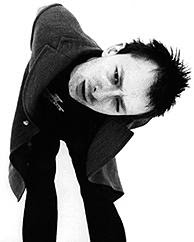GIMME SHELTER (1970)
MEETING PEOPLE IS EASY (1998)
Mick Jagger triumphant at Madison Square Garden, before the storm of Altamont in GIMME SHELTER.
ROCK documentaries are generally prosaic affairs, at best extended promos for their subjects, at worst overlong pop videos with bad interviews. There are noble exceptions, notably when film takes a group and views them in the context of a particular period. MEETING PEOPLE IS EASY plays as the quintessential 1998 rock documentary in the same way that GIMME SHELTER is a document for the death of the 1960s - it's as much about a moment in time as it is about the music.
The sheer thematic magnitude and angst of Radiohead’s OK Computer served time on the laddish anti-intellectualism of BritPop. Yet it is a work not of despair but of acceptance; such stoicism renders the album as a true articulation of the late twentieth century, music not only of extraordinary grace, but of experimental clarify. MEETING PEOPLE IS EASY charts director Grant Gee’s year on the road with Radiohead in the wake of OK Computer, offering an impressionistic study of the band launching, promoting and touring their pre-millennial masterpiece. Gee captures the banality of being a human product on the marketing treadmill; as gigs race past in a blur of fragmented images, the film is Kubrickian in its atmospheric melancholy, foreboding disorientation and technical mischief - interviews manage to be revealing without ever achieving coherence, sentences are chopped and diced, and television clips mashed into abstract art. The inflated vanities of most rockumentaries are strikingly absent, nor is there much orthodox concert footage, even though Radiohead’s music bleeds from every frame. Similar to Godfrey Reggio’s KOYAANISQUATSI - a dazzling collage of industrial images set to the music of Philip Glass - the film is a visual accompaniment to the scrambled emotions and shattered beauty of its source.
Radiohead talisman Thom Yorke. MEETING PEOPLE IS EASY portrays the frayed nerves of five sensitive souls trying to make sense of their spiralling fame. Yorke truly seems ill at ease everywhere except onstage, and even then his presence is intense but aloof.
Dubbed a snuff movie by Pauline Kael, GIMME SHELTER takes film and rock music and turns them into mirror images that could not begin to contain all the meanings. David and Albert Maysles, together with Charlotte Zwerin, capture this volatile mixture in their belief of direct cinema, a technique applying movie-making conventions to non-fiction work. Covering the Rolling Stones’ 1969 North American tour, it begins with performances at Madison Square Garden showing Mick Jagger and company at an artistic high. The band appeared capable of winning over any audience, but it's exactly this confidence - some might say overconfidence - that led to the problems at the Altamont free concert. In the wake of Woodstock, rock 'n' roll promised love and hope in a way of re-shaping the future. The Stones failed to understand how fragile this spell could become when invoked hastily; the venue was still in doubt a day before, and the resulting sanitary and medical facilities were woefully inadequate.
By the time Jefferson Airplane reach the stage, the struggles between the audience, stoned on bad acid and speed, and Hell’s Angels, hired as security, had become violent. With 300,000 people around a tiny stage, its rim inexplicably only four feet from the ground, and the bikers angrily bludgeoning with weighted pool cues, GIMME SHELTER contains little of the exhilaration of rock 'n' roll. During the Stones set, we see 18-year-old black man Meredith Hunter stabbed and beaten to death by the Angels twenty feet from the stage. We see the blur of a gun in Hunter’s hand, we see the glint of a knife guided by a biker as it hits its mark. With building hostility, the tendency is to mythologise Altamont as the nail in the coffin of the 60s, and Jagger as the Lucifer who called it into being. There is the look of disbelief on the people's faces, wondering how the Stones could go on playing in the bowels of violent death. The ashen expression on Jagger's face at the end, caught freeze-frame in the Maysles' editing suite, speaks a thousand words of remorse.


